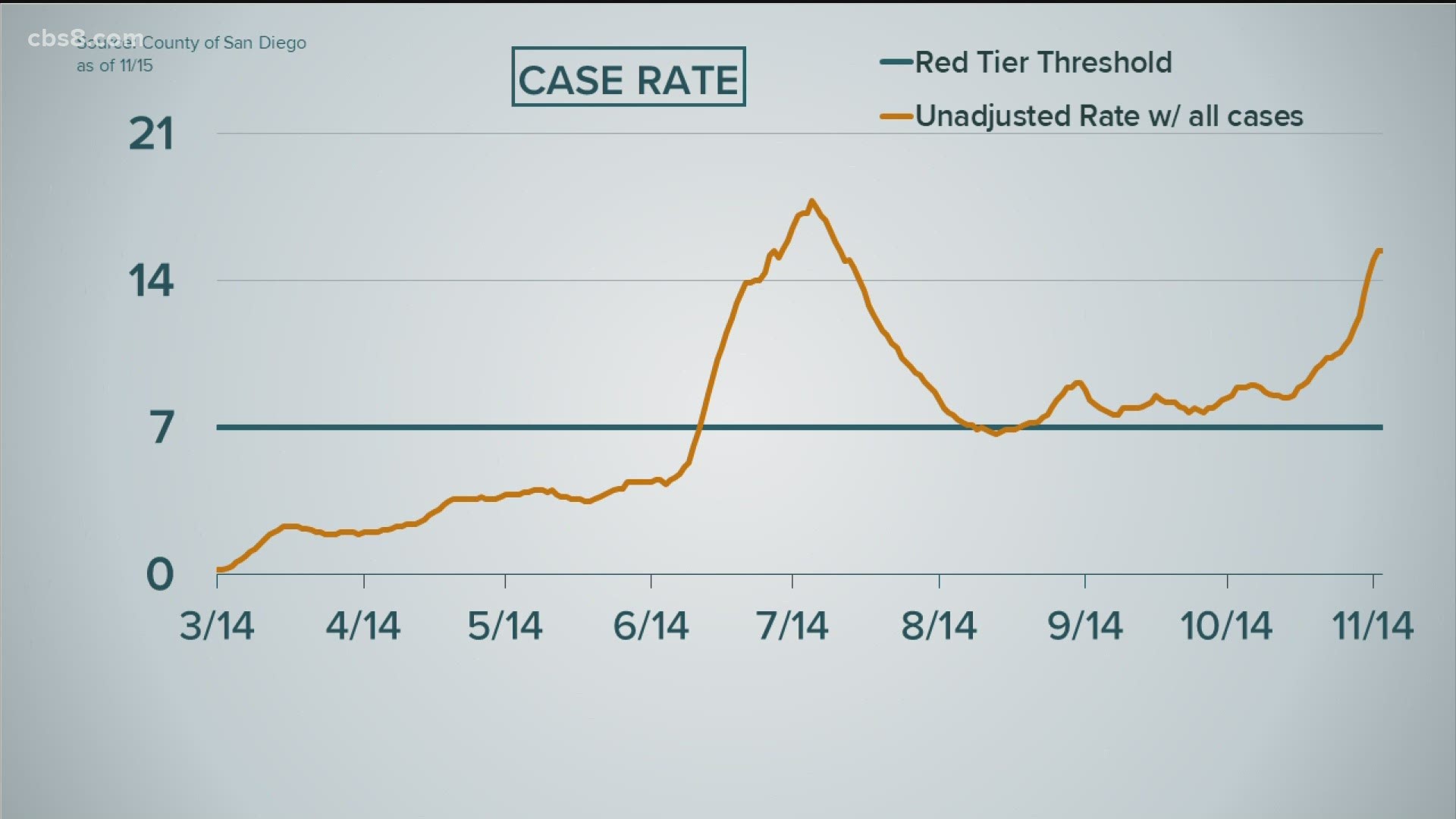SAN DIEGO COUNTY, California — State and local health officials continued sounding the alarm over the rising number of coronavirus cases. On Monday, the California Department of Public Health took the unprecedented step to release county case rates a day early. The data was then used to push more counties into the purple tier, the most restrictive level in the state’s Blueprint for a Safer Economy.
Gov. Gavin Newsom called the move pulling the “emergency brake” within the metric, which has provisions for the state to implement more restrictions faster when cases are rising exponentially. The move means an estimated 94 percent of Californians live in one of 41 counties that are in the purple tier. Three weeks ago, just nine counties were in the purple tier.
“The rate of increase is simply without precedent in California’s pandemic history,” said Newsom while explaining his decision.
San Diego County was placed in the purple tier last week and remains in the highest tier this week with an adjusted case rate of 10.7, after credits for doing more testing than the state median volume.
RELATED: Governor Newsom imposes new restrictions to curb COVID-19 in California
Critics of the move pointed to the number of available hospital and intensive care unit beds. Both have adequate capacity to handle cases. However, state and county health officials stressed a surge in hospitalizations lag about three to four weeks after an increase in cases.
“The daily average of new admissions into our hospital system for COVID increased by 27 percent between Oct. 25 and Nov. 7, a two-week period. Given the slope at which our cases are increasing, we can expect to see further increases in hospitalizations in the coming weeks, which is why we have to take action now,” said Supervisor Nathan Fletcher.
San Diego’s 12.1 unadjusted case rate is the highest since the state began using its current formula on Aug. 31. Projections for the upcoming week suggest the rate will continue to increase and could exceed 15.
News 8 estimates during the second wave of cases that hit over the summer, had the current metric been in use, it peaked at 17.8 on July 18.
Both the state and county have asked for voluntary compliance with the new restrictions. While many businesses and people are complying, some be it begrudgingly, a contingent of business owners and houses of worship, backed by area politicians are defying the restrictions.
El Cajon Mayor Bill Wells instructed his city’s police department to consider calls for service about the health order a “low priority.” While officers may talk with egregious violators, the department is not taking a punitive approach. Supervisor Jim Desmond, who represents District 5 on the Board of Supervisors, has also called for a loosening of restrictions to support businesses who been economically harmed by the pandemic.
“We hope the elected officials throughout San Diego County would realize this is a very serious situation we find ourselves in and, basically, abide by those things that they were sworn in to uphold,” said Board Chairman Greg Cox.
Cox authored a letter to mayors in the county’s 18 incorporated cities to ask for their assistance. He recognized National City Mayor Alejandra Sotelo-Solis as one of several mayors who have pledged their support. National City, and most South Bay communities, were among the hardest hit by coronavirus.
Separately, Wilma Wooten, M.D., the county’s public health officer also requested help enforcing the order from local law enforcement agencies. Even if they don’t agree or aren’t instructed to actively assist, the county can still enforce its order.
Compliance officers issued ten cease and desist letters to businesses that refused to comply with the changes over the weekend.
“We are in an emergency situation. COVID-19 is not going away, and we must act,” said Wooten, while announcing the county’s latest statistics. “You’re taking action not because I ask you to do so, but because the different entities that comprise the vital fabric of our community need you to take action and it’s just that simple.”
County data shows the bulk of cases are not coming from businesses that are affected by the latest restrictions under the purple tier. Instead, many can be traced back to worksites and home gatherings.
The state currently limits gatherings to three or fewer households and suggested those who live in purple counties should consider avoiding other people’s homes. It previously recommended a 14-day quarantine for people who return to California after leaving the state.
At least some of the latest cases can be attributed to Halloween gatherings although it may be too early to get a full picture because coronavirus has an incubation period of 14 days.
“The increased numbers that we are seeing now are not just from whatever gatherings occurred, but we do believe that our increases in numbers are due to people, again, not doing the things that we recommend they do,” said Wooten.
The state has not ruled out implementing additional restrictions if cases continue to rise at the current pace. It has also temporarily suspended counties from moving to a less restrictive tier until the case rate begins to decline.
“We’ve got to continue to have this dual approach of supporting those private gatherings to be low risk, but also doing the things within our business sectors that allow us to get this under control over the next many weeks,” said Mark Ghaly, Secretary of California Health and Human Services. “Hopefully [at] the end of December we’ve seen rates come down and we can get back to that forward movement in our tier system.”

